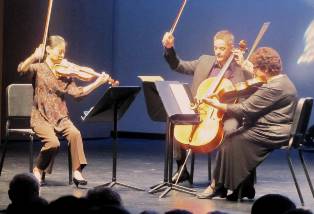
Midori Guests with CSO Chamber Players
The Cincinnati Symphony Orchestra Chamber Players closed
their 2013-14 season with a special guest March 28 in Mayerson Theater at the Erich Kunzel Center for Arts
and Education.

Violinist Midori sat in with the CSOCP (she is this weekend’s guest artist with the CSO) for Erno von Dohnányi’s Serenade for String Trio and helped sell out the house.
It was one of three numbers on a program of 20th-century chamber music, also including the Duo for Violin and Cello by Zoltan Kodály and Dmitri Shostakovich’s String Quartet No. 4 in D Major. It was a program notable for its virtuosity, its discourse on music and politics and for highly engaging listening.
Midori joined violist Marna Street and cellist Ted Nelson in the Dohnányi, a 1904 work that hearkens back to Brahms and earlier models rather than the nationalistic idioms espoused by Kodály and Béla Bartók. It received a delightful and thoroughly engrossing performance by the three players. The opening March was spirited and dramatic, while the Romanza opened with an ardent solo by Street. The lickety-split Scherzo had the instruments chasing each other merrily, with its own share of contrasting romance. The fourth movement, a theme with five variations, grew quite virtuosic at times, while the concluding Rondo, also a workout, was big, robust and lusty.
Shostakovich composed his Fourth String Quartet in 1949 but withheld it from public performance until after the death of Soviet dictator Josef Stalin in 1953. This was to avoid the consequences of advocating music too “serious” for the Stalinist regime (it also utilizes Jewish folk music, another non-no at the time). Performed by violinists Janet Carpenter and Chika Kinderman, violist Paul Frankenfeld and cellist Norman Johns, it opened over a cello drone for a sound akin to bagpipes. The waltz-like second movement grew impassioned before receding into plaintive, contrasting material. The Scherzo, a bit spooky in Shostakovich’s inimitable way, featured a big, dance-like episode for viola. The vigorous, dance-like finale, central focus of the quartet, incorporates vibrant Jewish folk idioms before slowing to a “serious,” restrained end. All of it was permeated by the yearning quality characteristic of Shostakovich’s music.
Violinist Kun Dong and cellist Susan Marshall-Petersen opened with Kodály’s Duo, a work written in 1914 on the cusp of World War I when the composer -- a noted ethnomusicologist like his compatriot Bartók -- was unable to travel to pursue his researches. It is filled to the brim with Hungarian folk color and makes considerable technical demands on the instruments, which are treated equally throughout. Both players produced a big, lush sound in the opening Allegro serioso, where they took turns accompanying each other. The slow movement was lovely, reflective and impassioned, while the finale, opening with a big flourish by Kun Dong on violin, was good humored, with lots of Magyar flair.
The CSO Chamber Players, chamber music component of the CSO, is organized and administered by the CSO musicians themselves. They present four programs a year in Mayerson Theater at the Erich Kunzel Center for Arts and Education (the School for Creative and Performing Arts). The players provide commentary from the stage, giving their events a very welcoming aspect. For information, visit www.cincinnatisymphony.org/chamber